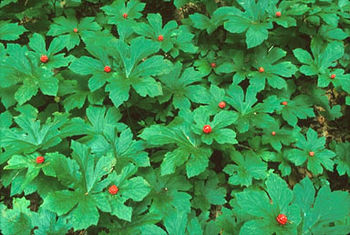Other names: Yellow root, Orange root, Puccoon, Ground raspberry, Wild curcuma
Goldenseal (Hydrastis canadensis) is one of the most popular herbs on the market today. It was traditionally used by Native Americans to treat skin disorders, digestive problems, liver conditions, diarrhea, and eye irritations. Goldenseal became part of early colonial medical care as the European settlers learned of it from the Iroquois and other tribes. Goldenseal gained widespread popularity in the early 1800s due to its promotion by a charismatic herbalist named Samuel Thompson. Thompson believed goldenseal to be a magical cure for many conditions. Demand for this herb dramatically increased, until Thompson's system of medicine fell out of popularity. Over the years, goldenseal has gone through periods of popularity. There is currently great demand for goldenseal which coupled with limited supply of wild-crafted sources, has driven the price of goldenseal up.
See also : Hydrastis
Special Precautions of Goldenseal
- Goldenseal should not be taken by pregnant women. One of goldenseal's chief constituents, berberine, has been reported to cause uterine contractions and to increase levels of bilirubin. Goldenseal should not be used by people with high blood pressure. Those with heart conditions should only use goldenseal under the supervision of a health professional.
- Don't use goldenseal in newborn babies. It is LIKELY UNSAFE for them. It might cause brain damage (kernicterus).
- The safety of goldenseal in nursing women, children, and people with kidney and liver disease is unknown. A hazardous chemical in goldenseal can cross the placenta and can also find its way into breast milk. Brain damage (kernicterus) has developed in newborn infants exposed to goldenseal. Do not use goldenseal during pregnancy or breast-feeding.
- Side effects include irritation of the mouth and throat, nausea, increased nervousness, and digestive problems. The liquid forms of goldenseal are yellow-orange and can stain.
- Cyclosporine (Neoral, Sandimmune) interacts with GOLDENSEAL
- Digoxin (Lanoxin) interacts with GOLDENSEAL
- Medications changed by the liver (Cytochrome P450 2D6 (CYP2D6) substrates) interacts with GOLDENSEAL
- Medications moved by pumps in cells (P-Glycoprotein Substrates) interacts with GOLDENSEAL
The benefits of Goldenseal are
- rich in Berberine.
- Cancer : contains the cancer preventing components berberine plus hydrastine. These compounds create an anti tumor effect in the body while consumed in amounts of around 750mg a day. Goldenseal should be rotated in a two to 3 weeks cycle with other herbs to be most effective.
- Goldenseal is available in nutritional supplement form. It is also available as a cream or ointment to heal skin wounds.
- Goldenseal herbal tincture can be used as a mouthwash or gargle for mouth sores and sore throats. A tea made of goldenseal can also be used for this purpose
- Goldenseal is a bitter that stimulates the secretion and flow of bile, and can also be used as an expectorant. It also has strong activity against a variety of bacteria, yeast, and fungi, such as E. Coli and Candida.
- Goldenseal is used for infections of the mucus membranes, including the mouth, sinuses, throat, the intestines, stomach, urinary tract and vagina.
- Several people have been using goldenseal as a remedy for colds and flu. According to studies, the action of goldenseal is towards the integrity of the mucus and sinus membrane. Through this action, the cells that produce the mucus is strengthened preventing over-production which results to runny nose and then clogged nose if there is inflammation. When goldenseal is combined with Echinacea, its effect in slowing down the symptoms and the severity of flu is enhanced.
Goldenseal is used for the following conditions:
- minor wound healing
- bladder infections
- fungal infections of the skin
- colds & flu
- sinus and chest congestion
